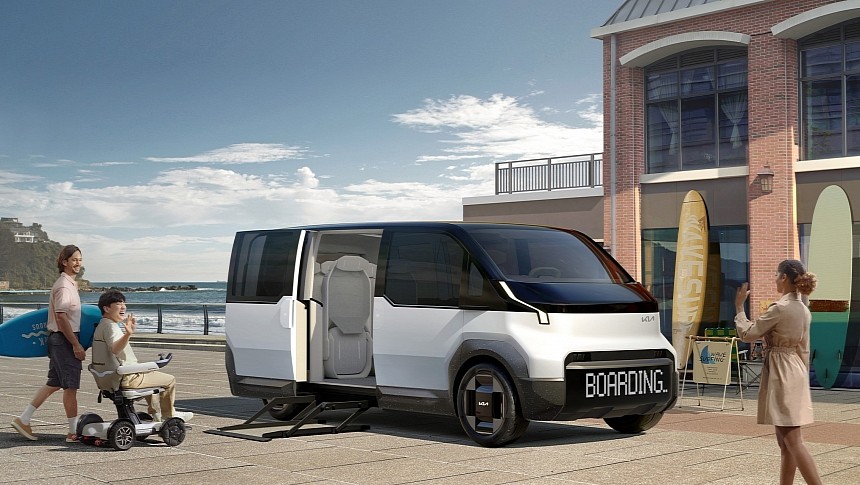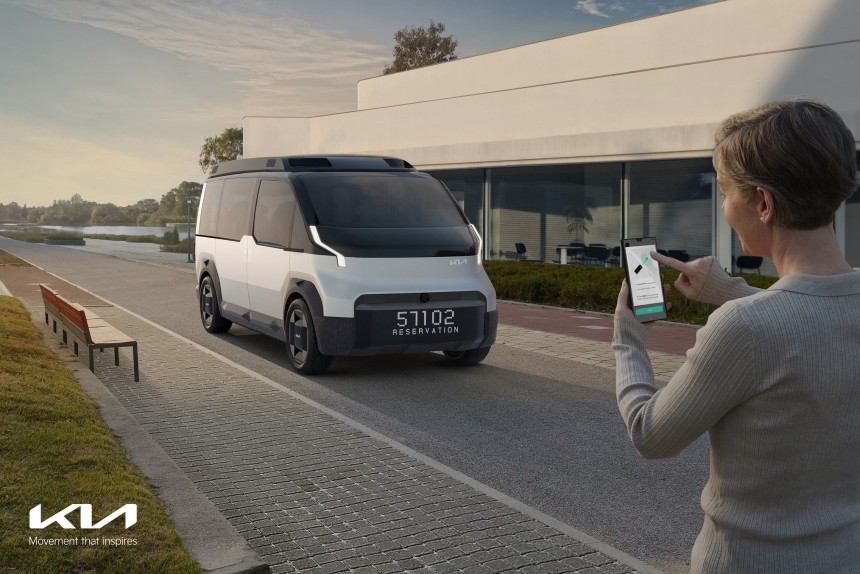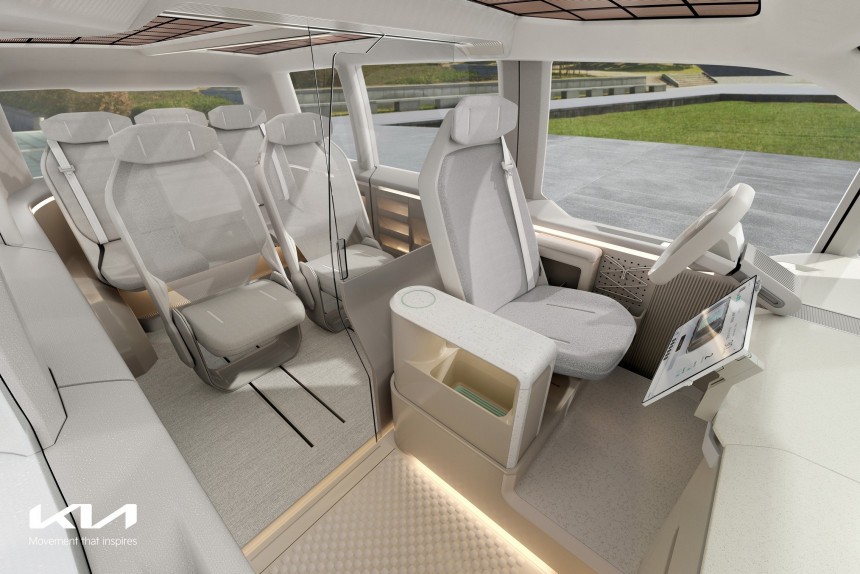Uber was at the time of its arrival into this world the biggest invention since toilet paper. Although for all intents and purposes it was not the first company to try its luck in the then-still-new ride-hailing business, it definitely was the one that put this concept on the map, made it globally famous, and caused tons of problems for traditional taxi companies.
As its popularity grew and Uber's bank accounts started filling with money, the company decided to be a technological trendsetter, and it was among the first to jump on the autonomous vehicle bandwagon.
In doing so Uber proved it is a business that doesn't shy away from trying out new ideas. So we were not all that surprised when hearing about the company quickly saying yes to South Korean carmaker Kia's proposal at CES 2024.
What proposal is that? For Uber to start using a weird and innovative new line of vehicles called Platform Beyond Vehicle (PBV). We discussed the Kia innovation at length earlier this week, but here's a refresher.
You know how today's vehicles are built in a factory and how, even if in some cases they share components with other vehicles, they need dedicated production lines to be made in a certain way. Well, Kia's PBVs are basically kits that once assembled can be adapted for a variety of uses, at the hands of the users themselves, and with little specialized tools.
How so? All PBV vehicles will be based on a weldless body structure called Dynamic Hybrid. They will be shipped to customers as kits, together with whatever modular elements they need for their business.
In essence, this approach would allow people to reconfigure the platform to serve whatever the momentary goal is: the things can turn into taxis, delivery vans, recreational vehicles, and who knows what else.
The transformation will be done in a simple fashion using a system called Easy Swap. It calls for various modules to be connected to the vehicle chassis by using electromagnetic and mechanical couplings.
Kia's idea seems quite daring, and even the carmaker admits this is a long-term project that will probably span for many, many years. But one has to start somewhere, and Uber seemed like the most sensible choice.
The two companies struck a deal at CES that would allow Kia to move faster with the development of the PBVs, and move Uber one major step closer to achieving its 2040 zero-emission goal – yes, the new South Korean vehicles will all be electric.
Under the deal, Kia will ultimately produce specific vehicles of this kind for use in fleets, including Uber's. We're promised they will be ride-hailing vehicles the likes of which our world is yet to enjoy on a large scale, with personalized riding environments (climate and sound control) and interactive rear-seat entertainment systems. Connected systems are also being eyed.
The vehicles will be integrated with the Kia Connect services, meaning Uber's people will have access to diagnostic and prevention, in a bid to minimize the effects of potential malfunctions. More importantly, to drive the cost of these vehicles down (it's unclear at this point how much Kia will charge for the tech), Kia and Uber are looking into alternative means of ownership, including a Battery as a Service (BaaS) subscription.
The exact specifications of the Kia Uber PBVs are not known at the moment, with the companies yet to look into exactly what is needed. We do know, however, what the South Koreans are planning in a wider sense.
The Kia plan has three phases. At first, a single vehicle called PV5 will be released, which will be offered in Basic, Van, High Roof, and Chassis Cab configurations. Later on, a PV5 robotaxi and a PV5 Pickup will also enter the market.
Each of them will be based on the same platform, but depending on variant they will offer their own sets of specifications. For Uber applications certain and unspecified fittings are being considered.
Kia plans to start production of the PBV vehicles in 2025 at a facility it is currently building in its home country. To make sure everybody understands how serious this is, the carmaker announced an annual production capacity of 150,000 vehicles.
Before we get there, though, we're likely to see a series of concepts and prototypes to be made as a result of the partnership with Uber. Only then will we get a better sense of how the future of urban mobility for hire will look like.
As for why Kia chose to go with Uber on this, the reason is simple and clearly explained by Uber's Vice President of Business Development, Susan Anderson: "Drivers on the Uber platform are already EV early adopters, going electric six to seven times faster than the general population in the US and Europe."
In doing so Uber proved it is a business that doesn't shy away from trying out new ideas. So we were not all that surprised when hearing about the company quickly saying yes to South Korean carmaker Kia's proposal at CES 2024.
What proposal is that? For Uber to start using a weird and innovative new line of vehicles called Platform Beyond Vehicle (PBV). We discussed the Kia innovation at length earlier this week, but here's a refresher.
You know how today's vehicles are built in a factory and how, even if in some cases they share components with other vehicles, they need dedicated production lines to be made in a certain way. Well, Kia's PBVs are basically kits that once assembled can be adapted for a variety of uses, at the hands of the users themselves, and with little specialized tools.
How so? All PBV vehicles will be based on a weldless body structure called Dynamic Hybrid. They will be shipped to customers as kits, together with whatever modular elements they need for their business.
In essence, this approach would allow people to reconfigure the platform to serve whatever the momentary goal is: the things can turn into taxis, delivery vans, recreational vehicles, and who knows what else.
Kia's idea seems quite daring, and even the carmaker admits this is a long-term project that will probably span for many, many years. But one has to start somewhere, and Uber seemed like the most sensible choice.
The two companies struck a deal at CES that would allow Kia to move faster with the development of the PBVs, and move Uber one major step closer to achieving its 2040 zero-emission goal – yes, the new South Korean vehicles will all be electric.
Under the deal, Kia will ultimately produce specific vehicles of this kind for use in fleets, including Uber's. We're promised they will be ride-hailing vehicles the likes of which our world is yet to enjoy on a large scale, with personalized riding environments (climate and sound control) and interactive rear-seat entertainment systems. Connected systems are also being eyed.
The vehicles will be integrated with the Kia Connect services, meaning Uber's people will have access to diagnostic and prevention, in a bid to minimize the effects of potential malfunctions. More importantly, to drive the cost of these vehicles down (it's unclear at this point how much Kia will charge for the tech), Kia and Uber are looking into alternative means of ownership, including a Battery as a Service (BaaS) subscription.
The exact specifications of the Kia Uber PBVs are not known at the moment, with the companies yet to look into exactly what is needed. We do know, however, what the South Koreans are planning in a wider sense.
Each of them will be based on the same platform, but depending on variant they will offer their own sets of specifications. For Uber applications certain and unspecified fittings are being considered.
Kia plans to start production of the PBV vehicles in 2025 at a facility it is currently building in its home country. To make sure everybody understands how serious this is, the carmaker announced an annual production capacity of 150,000 vehicles.
Before we get there, though, we're likely to see a series of concepts and prototypes to be made as a result of the partnership with Uber. Only then will we get a better sense of how the future of urban mobility for hire will look like.
As for why Kia chose to go with Uber on this, the reason is simple and clearly explained by Uber's Vice President of Business Development, Susan Anderson: "Drivers on the Uber platform are already EV early adopters, going electric six to seven times faster than the general population in the US and Europe."















